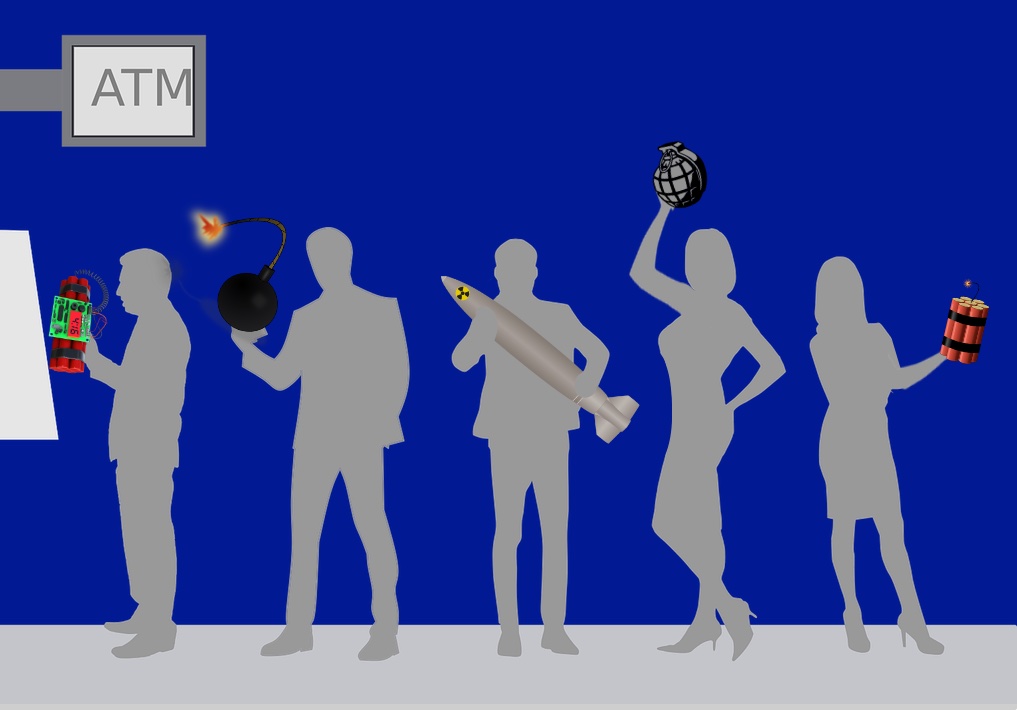
Oct 20
22
TBT: Whatever happened to caffeine for data?

This week’s TBT falls in the Whatever Happened To … category.
About this time in 2018, I blogged about Shiru Cafe and its unique approach to capturing and remarketing personal data. The company still operates, but not in the United States. Unable to secure corporate sponsors, Shiru Cafe closed its three U.S. location— less than two years after opening the first one.
No sooner did direct marketers commence salivating at targeting opportunities posed by that newfangled Internet thing … than the United States Congress and various regulatory bodies set about passing laws to hamper them.

Or, at least, that was the idea. Many rules are so plastic as to allow for a good deal of wiggle room—and marketers have proved adept wigglers since the dawn of time. The CAN-SPAM Act, for instance, forbids “false or misleading” headers; but one person’s “false and misleading” may be another’s “creative and charming.” Or, take retargeting, which provides a neat circumvention of rules against emailing website visitors without their express permission. Though it’s perfectly legal, a growing number of consumers are creeped out when ads for a recently searched product suddenly show up wherever they look.
The wisest course for building an online database has always been simply to request data along with permission to use it. Since people rarely give up something for nothing, marketers often dangle a compelling offer in exchange for data and permission. The offer is usually some sort of downloadable file—a document, music, video, images, etc.—or sometimes a non-downloadable incentive that requires shipment.
But SHIRU CAFE, a three-year-old Japanese company, has found a way to deliver a non-downloadable incentive on-the-spot in exchange for data.
SHIRU CAFE is at once a coffee shop and a gatherer and marketer of data.
If you’re a student at Brown University in Providence, Rhode Island, SHIRU is a coffee shop—but your money is no good there. The price for a cup of coffee at SHIRU is your personal data. According to NPR’s “The Salt” …
To get the free coffee, university students must give away their names, phone numbers, email addresses and majors, or in Brown’s lingo, concentrations. Students also provide dates of birth and professional interests, entering all of the information in an online form.
Faculty can pick up a cup of Joe for a dollar. Tough luck if you’re neither a student nor faculty member. You’ll have to go someplace else and pony up.
If you’re a corporate sponsor, SHIRU is a gatherer and marketer of data. Sponsors, if you were wondering, pay for the coffee by purchasing the data. Students who participate, continues NPR,
… open themselves up to receiving information from corporate sponsors who pay the cafe to reach its clientele through logos, apps, digital advertisements on screens in stores and on mobile devices, signs, surveys and even baristas.
It doesn’t take much imagination to understand the value marketers might place on that information. Financial institutions, for instance, could use it to identify students likely to someday prove valuable clients.
There’s no deception or sleight-of-hand going on. SHIRU is up-front about why they want students’ data and how they plan to share it.
As you’d expect, some find the idea distressing. Two Brown students recently called for a boycott. Others have set to work envisioning the worst and writing about it.
But come on. College students are big kids. Moreover, no one is forcing their participation. There’s an arguable win-win here, since database marketing is about matching marketers with more-likely prospects, and vice-versa.
Though the Providence café is SHIRU’s only U.S. store and hasn’t yet landed a sponsor, SHIRU operates a number of other profitable, corporate-sponsored cafés in Japan and India.
I’ll be interested to see if the concept grows in the U.S. If it does, expect knock-offs. It would be an easy matter for Starbucks or another chain to offer students coffee in exchange for data. Such would have an easy jump on SHIRU, since in the U.S. you can throw a textbook and hit three Starbucks stores.
For that matter, perhaps a bank looking to capture rising generations might strike a deal with coffee houses near college campuses, offering students free coffee on showing proof-of-account. Although many bank lobbies already make coffee available, a bona fide coffee house presents cachet—and an aura of quality—that no bank lobby can approach. Besides gathering data, a coffee house program would provide an incentive for students to open an account.
Surely there are other possibilities. Perhaps I’ll think of more. But first I’m going to need another shot of caffeine.

“There is nothing permanent except change,” declared sixth century BCE Greek philosopher Heraclitus. I would venture to say that modern society agrees with him, as evidenced by an abundance of expressions hinting that there is wisdom in making the most of change, and naught but folly in attempting to slow or stop it. For instance:
- Aviator Betty Green quipped, “Bending beats breaking.”
- UK Prime Minister Harold Wilson said, “The only human institution which rejects progress is the cemetery.”
- Trekkies gleefully quote the infamous Borg’s “Resistance is futile.”
- And we have history’s most prolific commentator, Anonymous, to thank for “If you can’t beat ’em, join ’em.”
In Darwinian terms, the financial services industry is a model of survival via adaptation, inventing and re-inventing itself through centuries of cultural, legal, and technological change. Readers may have noticed that Wells Fargo didn’t disappear when the great California Gold Rush of 1849 subsided in 1855, JP Morgan Chase is no longer a waterworks, and my employer Fiserv has moved well beyond its roots as a data processing company only.
Love thy enemy?
At first, the banking industry sounded alarms as fintechs proliferated and tech giants such as Google, Facebook, and Apple dangled their toes in financial services waters. They were, to put it bluntly, The Enemy.
Now, although cautions remain, alarms are fading with the realization that The Enemy’s continued incursion is unstoppable. And if that is so, the wiser tactic may not be to fight but to embrace. That is, to turn The Enemy into an asset.
This seems to be especially true for smaller institutions. Finn AI CEO Jake Tyler recently wrote for The Financial Brand,
A partnership with the big tech powerhouse could enable community banks and credit unions to offer a sophisticated digital experience quickly, including an alternative to Apple Pay … When Google announced that it had partnered with six more banks and credit unions on a checking account—in addition to its original two partners—it had many in the banking and fintech space scratching their heads … [but] Google has more than 67 million Google Pay customers, which could give its banking partners access to a huge potential customer base. It could also allow them to offer consumers a digitally focused experience, something that many traditional financial institutions—notably smaller banks and credit unions—struggle with.
But partnering with tech firms needn’t be the exclusive domain of tiny institutions. Just last month, Finextra reported on Google’s plans to provide co-branded accounts via eight US banks of varying size in terms of assets, including Bank Mobile, BBVA USA, BMO Harris, Coastal Community Bank, First Independence Bank, and SEFCU.
Moreover, if you have an Amazon Rewards Visa credit card, you probably know that it’s really a co-branded Chase card. As I noted in March, Goldman Sachs is partnering with Apple on the—what else would it be called?—Apple Card. And nearly a year ago, PYMNTS.com reported that Google had “… announced it will partner with Citigroup and Stanford Federal Credit Union to launch consumer checking accounts.”
Yet, PYMNTS.com argued elsewhere, “… instead of trying to be the bank, Google is leveraging the brand name, banking infrastructure and reputation for trust and stability of two banks.” The article, by Market Platform Dynamics CEO Karen Webster, continues:
[I]f successful, these accounts could become the cornerstone for the everyday app ecosystem that every Big Tech and FinTech player has its sights set on developing … to leapfrog their Big Tech and FinTech competitors and gain the consumer’s trust for keeping their funds safe … this ecosystem would link payments, banking, identity and commerce credentials to a funding source that does something no other FinTech or Big Tech ecosystem has been able to do at scale: capture the consumer’s primary paycheck and use it as the flywheel to make funds movement between those various ecosystem endpoints seamless, trusted and secure.
“What all banks and credit unions bring to Google’s table,” wrote The Financial Brand CEO and executive editor Steve Cocheo, “is the ability to offer insured deposits, connections to traditional payment rails, and regulatory compliance experience.”
Fine, but what’s in a Google alliance for banks? Citing consultants Richard Crone and Heidi Liebenguth of Crone Consulting, Cocheo suggests that merely avoiding being left out may provide incentive for financial institutions to play ball with Google:
If they aren’t with Google, they’ll be competing with partnerships offering the accounts. A major strength of fintechs … is their known ability to offer a customer experience, and innovation, superior to what most banks and credit unions offer. Those not allying with Google will need to be able to tap internal and vendor expertise to provide competitive digital experiences.
Holdout-purists may view partnering with fintechs as a treasonous act. But pragmatism has a habit of winning out in the end, especially in relatively free markets. This might be a good time to invoke the words of Patrick Henry, spoken in 1765 to the Virginia House of Burgesses on the subject of American independence: “If this be treason, make the most of it.”


It’s not hard to pick out the banker in a Western. Just look for someone sporting sleeve garters and a translucent visor.
This is a rare case in which Hollywood actually gets things right. In the late 19th century, sleeve garters served a practical purpose. Back then, you couldn’t walk into Nordstrom and ask for your neck size and sleeve length; if you couldn’t afford your own tailor, you made do with a one-size-fits-nobody. Shirt makers tended to err on the side of making sleeves way too long, so unless you wanted cuffs below your fingertips, you’d don garters to hoist them up where they belonged. This also helped reduce soiling from dragging sleeves over ink, dusty shelves, and musty documents.
Translucent green visors came along a little later on the heels of newfangled incandescent lighting. Clerks donned the visors to protect their eyes from the harsh overhead light of early bulbs. That’s also why green shades sit atop the traditional banker’s lamp.
Fast forward to a few decades ago …
Worsted and flannel suits in navy and charcoal gray had become all but required attire for bankers and other professionals. Suits were dark and somber for two reasons. One was that dark fabrics hide stains better than light ones. The other was that, until dry cleaning came along, the only way to make a stain “disappear” was to dye the whole suit a few shades darker.
Fast forward to today …
A growing number of banks are opting for business casual, having traded the suit and tie for khakis and sport shirts.
Assuming, that is, we’re talking about banks that still bother with physical locations. For all you know, your online banker could be in a T-shirt and blue jeans.
And that has marketing implications. Despite their practical origins, sleeve garters, visors, and, later, dark suits circled around to become symbols of professionalism. You could walk into a bank, see the attire, and—right or wrong—feel some assurance that you were dealing with competence.

The new challenge is to convey an aura of competence absent the traditional trappings that once characterized banks. That job increasingly falls to websites and apps. More than function, they must look and feel like the kind of business to whom people would willingly entrust their funds, business and personal information, and more.
Branding isn’t going away. Like everything else, it’s going digital.
As if we need more reasons to long for the pandemic’s end

There is no shortage of articles that, while acknowledging the horror that is the COVID-19 pandemic, observe or predict a resultant upswing in digital payments. More frequent use seems all but assured by the need to self-quarantine and shop from home. I have discussed as much in this space, including here, here, and here.
Which is why this recent Finextra headline caught my attention: “Payments revenue growth forecasts almost halved under brightest post-Pandemic outlook.”
Huh? Halved? What about all that talk of an inevitable upswing?
Finextra continues:
Annual global payments revenues could reach $1.8 trillion under a quick Covid-rebound scenario, according to data from the Boston Consulting Group, representing a considerable slowdown in growth from pre-pandemic boom times … Under a quick-rebound scenario, BCG’s outlook suggests that the global payments revenue pool will expand from $1.5 trillion in 2019 to $1.8 trillion in 2024, a compound annual growth rate of 4.4%. Although solid, this CAGR is much lower than the 7.3% annual growth the industry enjoyed from 2014 to 2019.
Yet it makes sense to lower expectations. While an increase of digital payment users would seem to follow from pandemic restrictions, an increase in use is another matter.
Going pants-less
While self-quarantining has increased the need for online shopping, it has diminished the need for many types of consumables. It wasn’t entirely surprising when CNN reported a measurable decline in pants sales in the pandemic’s early stages, which the phenomenon of pants-less Zoom meeting participants aptly symbolized. Per USA TODAY:
As working-from-home and teleconferencing become the new norm during the coronavirus pandemic, an executive from Walmart told Yahoo Finance on Thursday that there’s still a demand for presentable work shirts—but that there’s not much of a need for work clothing below the waist … As working-from-home and teleconferencing become the new norm during the coronavirus pandemic, an executive from Walmart told Yahoo Finance on Thursday that there’s still a demand for presentable work shirts—but that there’s not much of a need for work clothing below the waist.
There are other items and services that consumers suddenly manage to do without. Streaming is up, but theater ticket sales are down. Though people order meals via Grubhub and DoorDash, they cook more at home than before—partly to cope with lockdown boredom—which takes a heavy toll on the restaurant business. Indeed, the entire hospitality industry is suffering. Hotel vacancies are at an all-time high, airline ticket sales are down, and the cruise industry, if not on its last legs, is putting its legs on hiatus. As CNN Travel reported:
Hundreds of cruise ships that were sailing around the world earlier this year are largely now laid up at sea, with no passengers on board. There are many more vessels mid-construction, commissioned to meet the demand that characterized years of growth pre-2020, back when the $150 billion industry was booming. The result? An excess of ships. Cruise ships that once ferried passengers on vacations around the world now lie ready to be sold for scrap. This—teamed with financial difficulties arising from months of disruption—means some cruise companies are retiring ships earlier than expected. In September 2020, Carnival Corporation announced plans to sell 18 “less efficient” cruise ships in the coming months, resulting in a 12% reduction of its overall fleet.
Politico lists 11 other, less talked-about industries hard-hit by curbed spending, such as private investigation, pet-sitting, and tattoo parlors.
Not to be overlooked is the fact that millions of people simply have less to spend. Many aren’t earning and, therefore, not spending at all. The U.S. Bureau of Labor Statistics reported:
Of the 16.9 million people unemployed in July, 9.6 million (57 percent) were unable to work because their employer closed or lost business due to the pandemic. Among the unemployed, the vast majority of those on temporary layoff in July were unable to work because of the pandemic (78 percent).
Teenagers, PIs, tattoo parlors
Even teenagers are spending less. “Teen spending hit an all-time low during the coronavirus pandemic, according to Piper Sandler’s 40th biannual ‘Taking Stock with Teens’ report,” wrote Lauren Thomas for CNBC. Moreover:
Piper Sandler surveyed 9,800 consumers with an average age just under 16 from 48 states, with an average household income of $67,500. The survey, released Tuesday, was conducted between Aug. 19 and Sept. 22. Apparel spending came in at about $507 per teen per year, down 11% from last fall. Females, on average, are spending about $160 more on clothes than males, the survey said.
There’s no telling when the pandemic will abate to the point that business throughout the world returns to normal—whatever “normal” means. But the pandemic’s effects are farther-reaching than many might imagine. The markets will likely take a long, long time to recover.
Oct 20
8
TBT: From bezels to bombs: ATM fraud runs the gamut

Some thieves take on smart ATMs with high tech gadgetry. Others, you could say, have a shorter fuse.
The United States Department of Justice recently sent notifications to 2,000 residents in my home state of Utah. Recipients are presumed victims of one Alexandru Cosmin Licsor, freshly extradited from Romania. The purpose of the letter was to inform them of Licsor’s Salt Lake City trial, which begins one week from today. According to KSL.com:

Authorities said 37-year-old Alexandru Cosmin Licsor would install skimmers and cameras at ATMs along the Wasatch front then wait for customers to make withdrawals before cashing in on their hard-earned money …
“It reads the data on the bank cards and they get the pins from persons that enter their PIN. They usually have a camera and that’s how they were able to get the data and they just duplicate it,” said FBI special agent Dave Fitzgibbons …
According to the indictment, Licsor attempted to withdraw $512,960.13 and succeeded in withdrawing $189,740.30 from ATMs belonging to other banks and as far as New Mexico … The FBI suspects Licsor is part of a larger criminal organization operating in the Netherlands, Italy, Romania and Mexico.
“ATM fraud,” said one Utah resident who prefers I omit his name, “that’s still a thing?”
Yes, Virginia, ATM fraud is still very much a thing, and it doesn’t look like it’s going away anytime soon. Fraudsters develop and install myriad high tech hacks on ATMs. A new PYMNTS.com article reports that David Phister, systems security product management director for Diebold Nixdorf, said that …
… ATM skimming and jackpotting—where malicious code or hardware is installed at the machine to coax cash to be spit out on demand—remain among the most significant security concerns into the holiday season.
… Phister told PYMNTS that consumers should be especially vigilant about inspecting machines for “false bezels,” which are typically fixed over the card reader or other parts of the ATM, and which can house tiny “pinhole” cameras that record PINs as they are entered on keypads.
Consumers are well advised toward vigilance, but then, there’s only so much that the untrained eye can be expected to detect. False bezels are hard enough to spot, but at least they’re mounted on the ATM exterior. Data theft devices hidden inside the card slot present a bigger challenge—even to the better trained eye. PYMTS.com continues:
Another tactic involves the use of razor skimmers, which [Phister] described as part of the newest wave of fraud. They are, well, razor-thin inserts that fit within the card acceptance slot, and read the data housed within the magnetic stripe of cards inserted into the hacked ATM.
But not all ATM thieves resort to high-tech solutions. Some rely on the more traditional, Butch Cassidy-esque approach, which is to say, explosives.
In the Netherlands, blowing open ATMs had become so prevalent that, just a few weeks ago, ABN AMRO took the drastic step of emptying and shutting down 470 ATMs. In an official press release, ABN AMRO announced that it …
… has temporarily shut down 470 cash dispensers with immediate effect. This emergency measure is needed in view of the growing number of violent ATM explosive attacks. All cash has been removed from the machines. The past few months have seen a sharp rise in violent ATM explosive attacks, particularly targeting a certain type of cash dispenser used by ABN AMRO.
The move won’t leave ABN AMRO customers entirely ATM-less, however, for only about half of its ATMs are of that “certain type.” The press release continues, “At another 400 locations, ABN AMRO has different types of cash dispensers. These will remain open for use.”
Meanwhile, other Dutch banks, preferring not to tempt explosive fate, are emptying and shutting down ATMs between 11pm and 7am. On December 19, Finextra reported that:
… the operator of the Dutch banking sector’s joint ATM network says the overnight shutdown will take effect immediately. The firm will also move any cashpoints that pose an elevated risk to nearby residents and place them in safer locations. The company is working with De Nederlandsche Bank and the police to implement new measures which will render banknotes worthless if stolen by raiders.
Also:
Over 70 people have been arrested so far this year in connection with ATM bomb attacks by special ATM Raids Units set up by the Dutch police force.
“Digital security is an arms race,” I wrote in this blog in August of 2017:
Each time the good guys come up with a new way to foil hackers, the hackers simply busy themselves defeating it. I don’t expect the arms race to end anytime soon, if ever. Not even chip cards will do away with fraud, although chip use in Canada and other countries has reduced it.
What I seem to have overlooked at the time was that, for criminals who prefer not to trouble themselves with technology, there’s always dynamite.